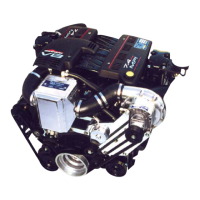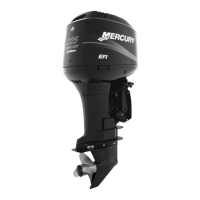Section 4 - Maintenance
Page 42 90-8M0113857 eng DECEMBER 2015
Cleaning the Flame Arrestor
!
WARNING
Fuel is flammable and explosive. Ensure that the key switch is off and the lanyard is positioned so that the engine cannot
start. Do not smoke or allow sources of spark or open flame in the area while servicing. Keep the work area well ventilated
and avoid prolonged exposure to vapors. Always check for leaks before attempting to start the engine, and wipe up any
spilled fuel immediately.
1. Disconnect and remove the crankcase ventilation hose from the fitting on the flame arrestor and valve cover.
2. Remove the flame arrestor.
a - Locknut
b - Sealing washer
c - Typical carburetor
d - Crankcase ventilation hose
e - Flame arrestor
3. Clean the flame arrestor with warm water and a mild detergent.
4. Inspect the flame arrestor for holes, cracks, or deterioration. Replace if necessary.
5. Allow the flame arrestor to air dry completely before use.
6. Clean the crankcase ventilation hose with warm water and a mild detergent. Dry with compressed air or allow to air dry
completely.
7. Inspect the crankcase ventilation hose for cracks or deterioration. Replace if necessary.
8. Install the flame arrestor, sealing washer, and locknut. Torque the flame arrestor locknut.
Description
Nm lb. in. lb. ft.
Flame arrestor nut 12 106
9. Connect the crankcase ventilation hose to the fitting on the flame arrestor and valve cover.
Positive Crankcase Ventilation (PCV) Valve
Changing
NOTE: We recommend the use of Mercury MerCruiser replacement parts to ensure compliance with emission regulations.
NOTE: On V6 models the PCV valve is nonserviceable and is an internal component of the valve cover.
1. Remove the PCV valve from the port valve cover.
a - PCV valve
b - Hose
mc71925-1
a
b
